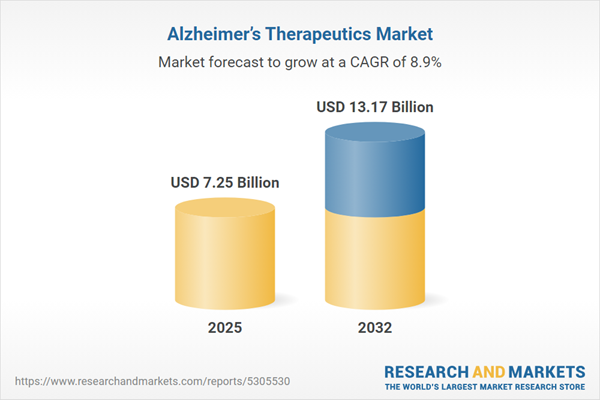Speak directly to the analyst to clarify any post sales queries you may have.
The Alzheimer’s therapeutics market is rapidly evolving, creating both opportunities and challenges for senior leaders navigating changing science, regulations, and patient expectations. Market participants must respond with effective strategies to sustain competitive positioning and drive long-term growth.
Market Snapshot: Alzheimer’s Therapeutics Market Growth and Outlook
As of 2024, the global Alzheimer’s therapeutics market is valued at USD 6.66 billion, with a projected compound annual growth rate (CAGR) of 8.88%. This expansion is propelled by momentum in treatment innovation, a shift toward precision medicine, and increasing regulatory agility. Accelerated clinical development and optimized trial design are reducing time to market, while targeted regional investments reinforce the industry’s global footprint. Senior decision-makers need to stay alert to changes in clinical practice, evolving regulatory frameworks, and operational efficiencies to ensure that organizational resources are aligned with market dynamics.
Scope & Segmentation: Strategic Overview for Alzheimer’s Therapeutics
This report analyzes critical market segments and regional factors shaping Alzheimer’s therapeutics, providing actionable insights for product planning, commercialization, and technology adoption across varied geographies and patient segments.
- Therapy Types: Biologics, small molecule drugs, and combination therapies each support product strategies tailored to different clinical and patient demands.
- Mechanisms of Action: Amyloid beta inhibition, cholinesterase inhibition, NMDA antagonism, and tau targeting remain core drivers of therapeutic research, guiding investment and development activities.
- Formulations: Oral tablets, injectables, and transdermal patches facilitate therapy delivery for diverse patient needs and treatment infrastructures.
- Delivery Modes: Intravenous, oral, subcutaneous, and transdermal administration methods add flexibility for both acute and home-based care models.
- Distribution Channels: Hospital pharmacies, retail pharmacies, specialty clinics, and neurology centers ensure widespread therapy access and support strong value chain integration.
- End Users: Home care providers, hospitals, and long-term care facilities require adaptable solutions to meet unique institutional and patient requirements.
- Disease Stages: Early onset, mild to moderate, and advanced segments allow customized strategies across the disease continuum.
- Geographic Coverage: Americas, Europe, Middle East & Africa, and Asia-Pacific are each shaped by distinct regulatory environments, demographics, and infrastructure, affecting commercial strategies and market entry decisions.
- Technology Focus: Digital biomarkers, genomics, proteomics, advanced diagnostics, and remote monitoring are enabling personalized care and more informed decision-making.
- Key Companies Profiled: Biogen Inc., Eisai Co. Ltd., Eli Lilly and Company, F. Hoffmann-La Roche Ltd, Novartis AG, Johnson & Johnson, AbbVie Inc., Pfizer Inc., Merck & Co. Inc., and AC Immune SA are highlighted for innovation and influence.
Key Takeaways for Strategic Leadership
- Immunotherapy and digital health integration are quickening the pace of product launches and expanding the therapeutic landscape to serve emerging patient needs more efficiently.
- Regulatory changes and payer dynamics are increasing the need for adaptive compliance approaches and flexible operating models.
- Building resilient supplier networks and embracing agile procurement can help fortify manufacturing reliability in response to evolving global supply scenarios.
- Shifts in research focus toward targeted protein therapies and advancements in neurology are deepening and diversifying clinical pipelines for future innovation.
- Patient-centric care models, combined with streamlined service delivery, are becoming key differentiators for payer collaboration and patient satisfaction, especially in home and institutional settings.
Tariff Impact on Alzheimer’s Therapeutics Supply Chain
Recent U.S. tariffs on pharmaceutical ingredients and equipment are contributing to higher production costs and greater supply chain complexity. Organizations are responding by diversifying suppliers, applying agile procurement practices, and strengthening international collaborations. These efforts are aimed at maintaining continuity of supply and achieving regulatory compliance in a shifting trade environment.
Methodology & Data Sources
Research in this report is drawn from direct interviews with clinicians, industry executives, and regulatory officials and is supported by analysis of peer-reviewed literature and leading industry white papers. This approach delivers a comprehensive base for decision-making and risk planning.
Why This Report Matters for Strategic Leadership
- Enables decision-makers to align market expansion and investment planning with emerging regional and industry-specific trends in the Alzheimer’s therapeutics market.
- Arms executive teams with the latest intelligence on evolving regulatory standards, new therapy technologies, and trade-related risks to improve future preparedness.
- Provides in-depth contextual analysis designed to reinforce competitive positioning and optimize long-term resource allocation.
Conclusion: Navigating Alzheimer’s Therapeutics Market Complexity
Adaptable strategies and a proactive focus on resilient, patient-centered operations will best equip senior leaders to guide their organizations through the changing landscape of Alzheimer’s therapeutics and maintain market relevance.
Additional Product Information:
- Purchase of this report includes 1 year online access with quarterly updates.
- This report can be updated on request. Please contact our Customer Experience team using the Ask a Question widget on our website.
Table of Contents
3. Executive Summary
4. Market Overview
7. Cumulative Impact of Artificial Intelligence 2025
Companies Mentioned
The companies profiled in this Alzheimer’s Therapeutics market report include:- Biogen Inc.
- Eisai Co., Ltd.
- Eli Lilly and Company
- F. Hoffmann-La Roche Ltd
- Novartis AG
- Johnson & Johnson
- AbbVie Inc.
- Pfizer Inc.
- Merck & Co., Inc.
- AC Immune SA
Table Information
| Report Attribute | Details |
|---|---|
| No. of Pages | 188 |
| Published | November 2025 |
| Forecast Period | 2025 - 2032 |
| Estimated Market Value ( USD | $ 7.25 Billion |
| Forecasted Market Value ( USD | $ 13.17 Billion |
| Compound Annual Growth Rate | 8.8% |
| Regions Covered | Global |
| No. of Companies Mentioned | 11 |









